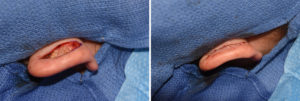Otoplasty is a well known ear reshaping procedure. Pinning the ears back, as it is often called, changes the shape of the ear cartilage through sutures and sometimes cartilage excisions. Done from an incision on the back of the ear it is often combined with other facial procedures due to surgical proximity and convenience. But it is always done in the supine position on the operating table and each ear is accessed by turning the head from side to side. The success and symmetry of the ear reshaping is then judged from the frontal view as the patient would see it.
There are some uncommon situations, however, when the performance of an otoplasty can be done from a different viewpoint or angle. This would be the ‘need’ to do an otoplasty in the prone or face down position. I have done this numerous times when performing simultaneous occipital skull implant and webbed neck corrective procedures. Both types of deformities have a high association with ear deformities particularly of the protruding type.

When performing an Upside Down Otoplasty one must be careful to not over correct or pull the ear back too far. This is fairly easy to do since closing done the angle of the ear to the side head is easily seen. But as long as the helium to mastoid skin distance is at least 15mms the ear will not become too pulled back. Another favorable sign is if the antihelical rim is not seen sticking out beyond the helical rim.
Dr. Barry Eppley
Indianapolis, Indiana



